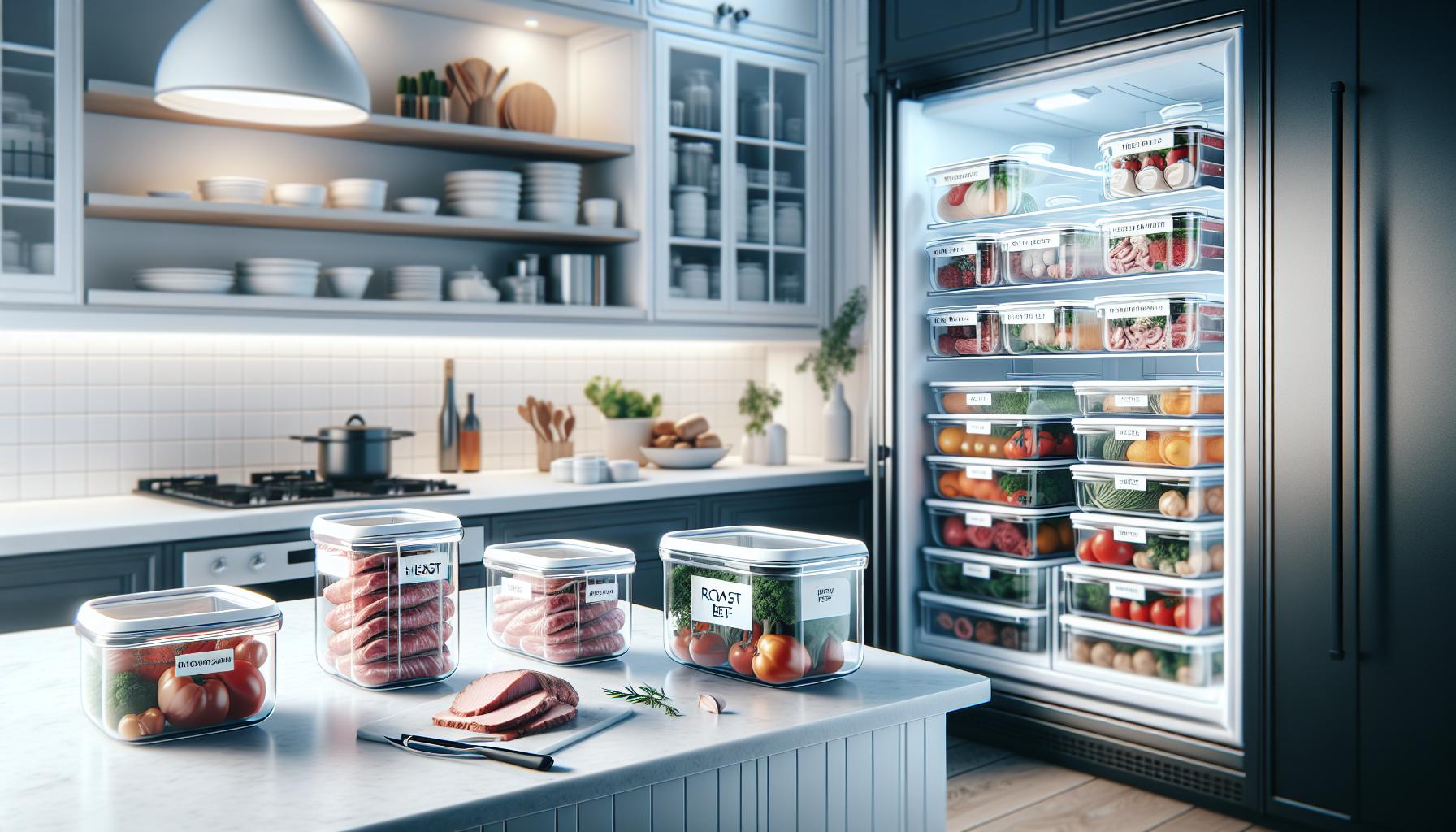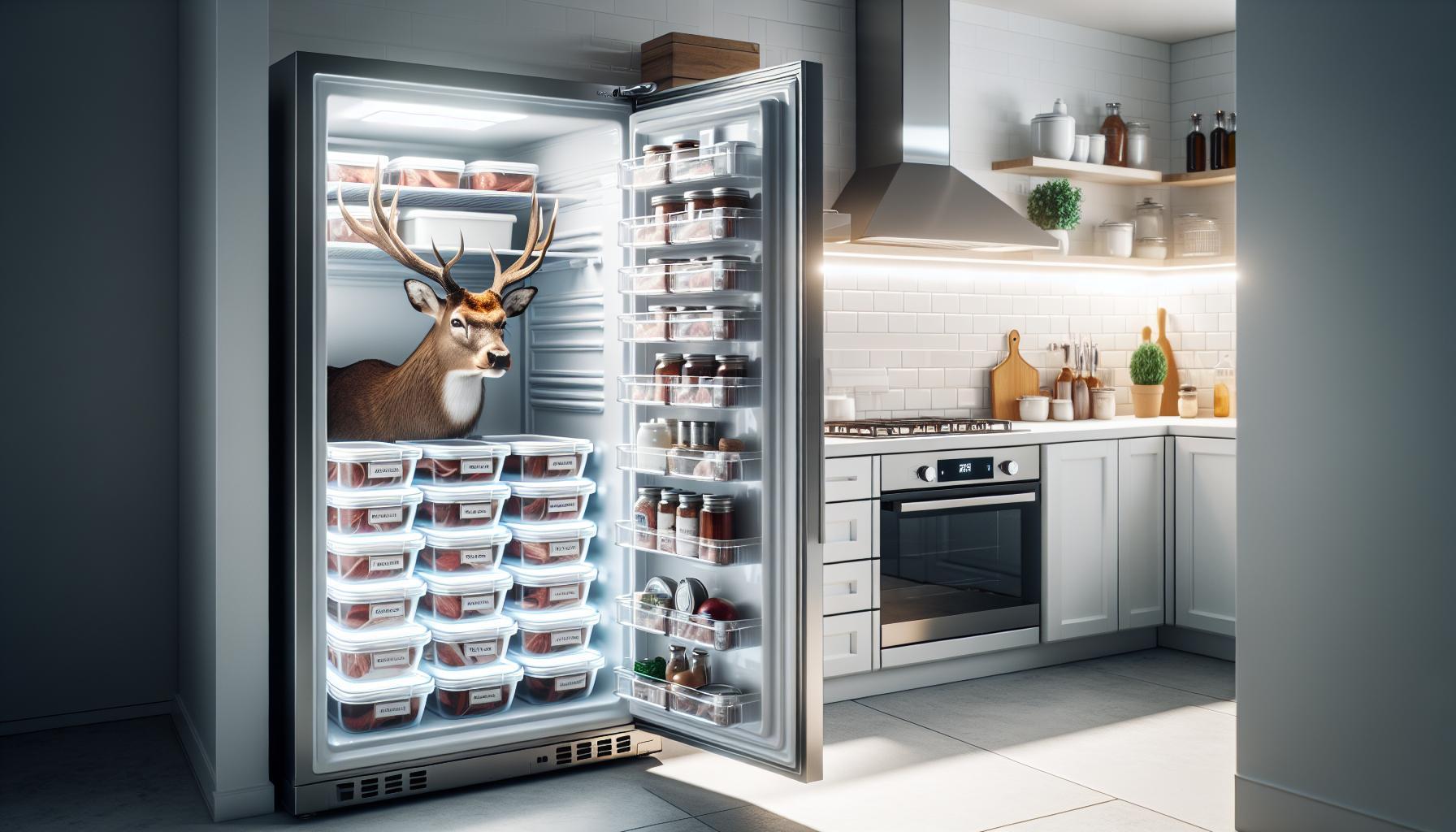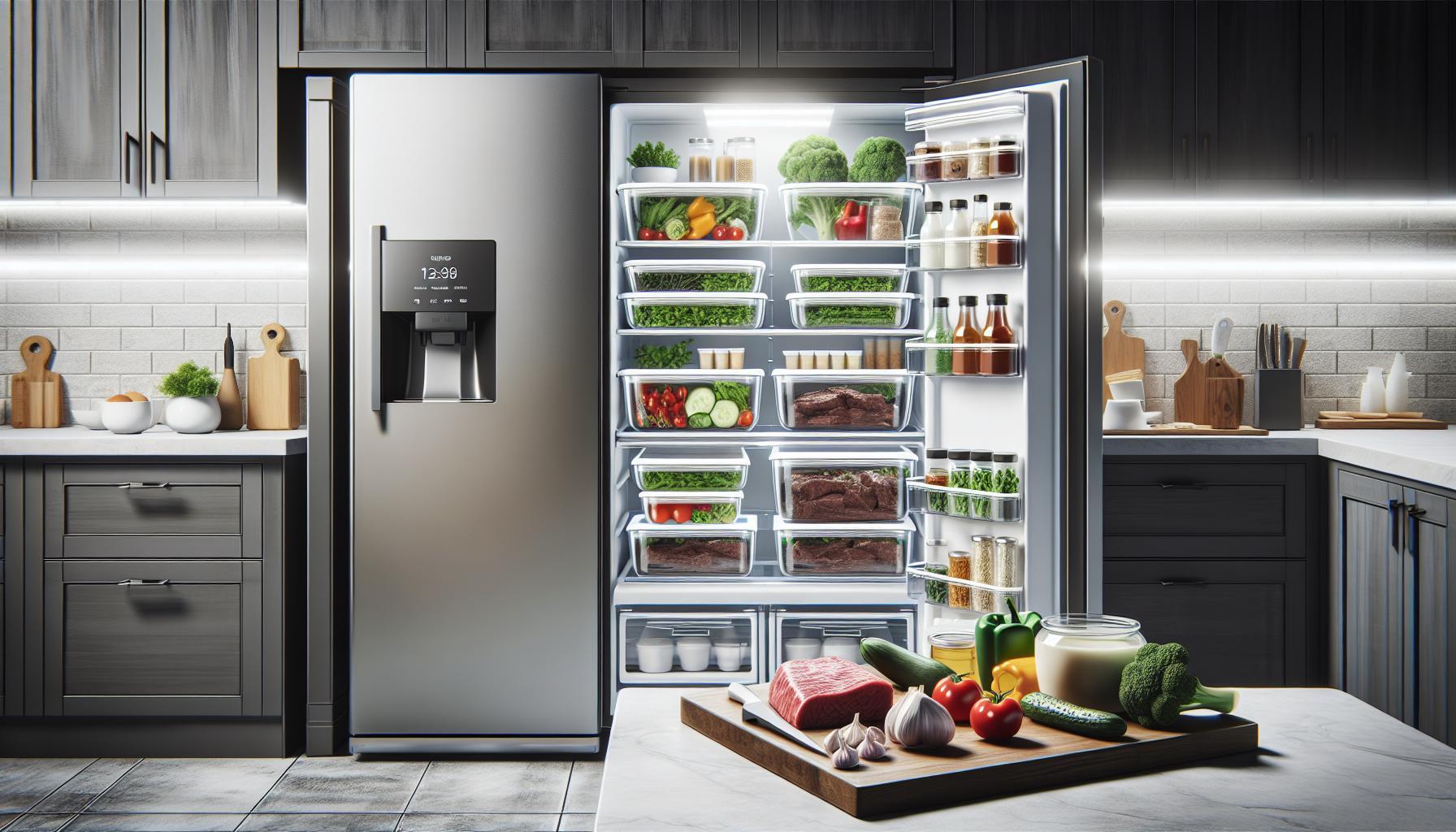Roast beef is a cherished dish, often served at family gatherings and special occasions, but knowing how to properly store it is crucial for both taste and safety. Understanding how long roast beef lasts in the fridge can help you avoid waste while ensuring that your leftovers remain delicious and safe to eat.
Many home cooks face the dilemma of keeping their meals fresh without risking spoilage. By following proper storage guidelines, you can enjoy tender, flavorful roast beef days after the initial feast. Curious about how to maximize your leftovers and make informed decisions about safe consumption? This guide will provide you with essential tips on storage durations and safety practices to keep your roast beef at its best.
How Long Can Roast Beef Stay Fresh?

Properly storing roast beef is essential to ensure it remains safe to eat and retains its flavor and tenderness. Generally, cooked roast beef can stay fresh in the refrigerator for 3 to 4 days, while leftovers should also be consumed within this timeframe. To maximize freshness, always store roast beef in airtight containers or tightly wrapped in aluminum foil or plastic wrap. Ensure your refrigerator is set to 40°F (4°C) or below, as this temperature helps slow bacterial growth.
When considering how long roast beef may last, it is crucial to note that the timeframe can also depend on whether the meat has been sliced. Sliced roast beef may have a shorter shelf life-around 3 days-compared to whole cuts. If you are unsure about how long the roast beef has been stored, always rely on your senses. If the meat has an off smell, a slimy texture, or any discoloration, it is safest to discard it.
If you have leftovers that you cannot consume within the recommended period, freezing is an excellent option. Properly frozen roast beef can last up to 6 months in the freezer without significant loss of quality. To freeze, wrap the beef tightly in freezer-safe packaging to prevent freezer burn and maintain flavor. Always label the packaging with the date to track storage times effectively.
Signs Roast Beef Has Gone Bad

Recognizing when roast beef has gone bad is crucial for food safety and maintaining optimal flavor. Spoiled roast beef can lead to foodborne illnesses, and understanding the signs can help you avoid potential health risks. One of the first indicators is an off smell; fresh roast beef should have a mild, beefy aroma. If you detect a sour or rancid odor, it’s best to err on the side of caution and throw it away.
Another key sign to watch for is a slimy texture. Freshly cooked roast beef should feel firm and slightly moist, but if it develops a slippery or tacky surface, this suggests bacterial growth. Discoloration is also an essential visual cue. While some browning is normal due to oxidation, an unusual green or gray hue indicates spoilage. If the meat appears dull instead of the typical bright red or pink of fresh beef, it’s time to discard it.
When assessing your roast beef, consider these factors comprehensively. If any of these signs are present, don’t take the risk of consuming the meat. Always prioritize safety; if you have any doubts about the quality of the roast beef, it’s better to throw it away than to compromise your health. Being proactive in identifying spoilage can save you from unpleasant consequences and ensure every meal remains enjoyable.
Best Storage Practices for Roast Beef

Proper storage of roast beef is essential for maintaining its freshness, flavor, and safety for consumption. Storing roast beef the right way not only extends its shelf life but also ensures you can enjoy tender and juicy slices in future meals. Here’s how to do it effectively.
To keep roast beef fresh in the refrigerator, it should be stored in an airtight container or tightly wrapped in plastic wrap or aluminum foil. This prevents exposure to air, which can lead to drying out and oxidation, ultimately affecting taste and texture. Generally, cooked roast beef can be safely stored in the refrigerator for about 3 to 4 days. If you want to extend storage beyond this, consider freezing it, which can maintain quality for up to 4 to 6 months, provided it’s stored correctly.
Best Practices for Refrigerator Storage
- Cool Before Storing: Let roast beef cool to room temperature before putting it in the refrigerator to avoid raising the internal temperature of the fridge.
- Use a Meat Thermometer: Ensure roast beef reaches a safe cooking temperature (at least 145°F) before storing.
- Label and Date: Use a marker to label containers or wraps with the date of storage to keep track of freshness.
- Avoid Overcrowding: Store cooked meat in a part of the fridge where air can circulate freely, preventing moisture buildup.
If you anticipate not using the roast beef within a few days, freezing is advisable. Wrap the beef in freezer-safe materials, ideally vacuum sealing, which helps prevent freezer burn. Remember, while the beef can still be safe after several months in the freezer, the quality will start to diminish over time. Always defrost in the refrigerator rather than at room temperature to ensure food safety. By following these storage methods, you can enjoy your roast beef at its best, while minimizing the risk of spoilage.
Freezing Roast Beef: What You Need to Know
Freezing is a fantastic way to prolong the life of your roast beef while retaining its flavor and texture. When done correctly, freezing can preserve the quality of cooked roast beef for approximately 4 to 6 months. Before you freeze, it’s essential to prepare the roast properly to avoid problems like freezer burn, which can ruin the taste and texture of the meat.
To start, allow the roast beef to cool completely at room temperature. This step is crucial because placing hot meat directly into the freezer can raise the overall temperature inside, potentially affecting the safety of other stored foods. Once cooled, slice the roast into portions if you prefer easier thawing later. Wrap each piece tightly in plastic wrap to eliminate air exposure. For even better protection, place the wrapped portions in an airtight freezer bag or vacuum-seal them, which helps maintain moisture and prevent freezer burn.
When it comes time to thaw the frozen roast beef, do so safely by transferring it to the refrigerator a day before you plan to use it. This method ensures a gradual defrost, which minimizes the growth of bacteria. Avoid defrosting at room temperature, as this can create unsafe conditions. If you accidentally freeze roast beef again after thawing, it’s generally not recommended due to potential changes in texture and taste, although it can still be safe if done promptly and maintained at safe temperatures.
Remember, while freezing is a great option, preparing for the day after you freeze is just as important. By adhering to these practices, not only do you extend the life of your roast beef, but you also maintain its delicious quality for future meals, ensuring every bite is as enjoyable as the first.
How to Reheat Roast Beef Without Drying It Out
To enjoy leftover roast beef without sacrificing its tenderness and flavor, reheating properly is essential. The goal is to warm it through gently while retaining moisture. High temperatures can quickly lead to dry and tough meat, so using the right technique is crucial.
One effective method is to reheat roast beef in the oven. Preheat your oven to 250°F (120°C). Place the roast beef in a baking dish and add a splash of beef broth or water to create steam. Cover the dish tightly with aluminum foil to trap moisture and heat it evenly. Heat the beef for about 20 to 30 minutes, checking regularly until it reaches an internal temperature of 130°F (54°C) for medium-rare or as desired. This low and slow method helps keep the juices inside, preserving the tenderness.
Alternatively, if you’re short on time, the stovetop can also be effective. Slice the roast beef into thinner pieces for quicker heating. Place a skillet over medium-low heat and add a little beef broth or water to the pan. Once the liquid is simmering, add the sliced beef. Keep them moving in the pan to prevent any from drying out until heated through, usually around 5 to 10 minutes.
Lastly, consider using a microwave if you need to reheat fast, but it requires extra caution. Use a microwave-safe dish and cover it with a damp paper towel to trap steam. Heat on low or medium power for short bursts of about 30 seconds, then check for doneness. This method can easily overcook the beef, so keep an eye on it.
By selecting the right reheating method and monitoring the temperature closely, you can enjoy your roast beef just as tender as when it was first served. Ensuring it remains moist is not only about technique but also about avoiding extremes-too much heat or time can lead to disappointment. Enjoying your leftovers can be quick, easy, and delicious without losing those savory flavors.
Choosing the Right Container for Storage
When it comes to safeguarding your leftover roast beef, the choice of storage container can significantly impact its freshness and quality. Storing your roast beef correctly not only helps maintain its flavor but also ensures safety by minimizing the risk of bacterial growth. The ideal container will retain moisture while preventing exposure to air, which can lead to spoilage.
Choosing an airtight container is paramount. Look for a durable, food-grade plastic or glass container with a tight-fitting lid to create a seal. This ensures that the roast beef remains moist and fresh. If you can’t find an airtight container, you can also tightly wrap the roast beef in aluminum foil or plastic wrap, making sure to eliminate as much air as possible. For those who are environmentally conscious, reusable silicone bags are also a great option, providing a flexible and sealable alternative to traditional plastic.
For optimal safety and quality, store the roast beef in the refrigerator at a temperature below 40°F (4°C). When properly stored, roast beef can generally last for up to three to four days in the fridge. It’s crucial to avoid storing your roast beef at room temperature, as this can promote rapid bacterial growth, leading to foodborne illnesses.
If you’re unsure about your container’s effectiveness, consider using a labeling system. Mark the date when the beef was stored to help keep track of its freshness. Remember to inspect your roast beef before consuming it; if you notice any off smells or a change in color, it’s best to err on the side of caution and discard it. By following these guidelines on choosing the right storage container, you can enjoy your roast beef safely and deliciously for days to come.
Understanding Expiration Dates on Meat
is crucial for ensuring food safety and maintaining the quality of your meals. Generally, you will encounter two types of dates on meat packaging: the “sell by” date and the “use by” or “expiration” date. The “sell by” date is primarily for retailers to manage inventory and should not be confused with safety. It indicates the last date a store should sell the product. Meanwhile, the “use by” or “expiration” date is the manufacturer’s guarantee of peak quality. After this date, the meat may not be safe to consume.
When it comes to roast beef, properly interpreting these dates can help you avoid potential foodborne illnesses. For fresh roast beef, it typically lasts about 3 to 4 days in the refrigerator after purchase, provided it’s stored correctly at or below 40°F (4°C). If the beef has been prepackaged and you’re unsure about its freshness, always check for both the sell by and use by dates. If the use by date has passed, it’s best to err on the side of caution and discard the meat, even if it looks and smells normal.
Additionally, understanding the physical signs of spoilage is essential. If your roast beef exhibits any of the following characteristics, it’s likely no longer safe to eat:
- Unpleasant odor-meat should smell fresh.
- Color changes-brown or grey spots may indicate spoilage.
- Slime or stickiness-this is often a sign of bacterial growth.
To extend the shelf life of roast beef, consider freezing it before the expiration date. Frozen roast beef can last for several months, maintaining its quality if properly wrapped. Remember, even when it’s frozen, it’s advisable to consume it within six months for the best flavor and texture. Always label your meat with the date it was frozen to manage its freshness effectively. Following these guidelines helps ensure that you handle roast beef safely, allowing you to enjoy your meals without worry.
Can You Safely Refreeze Roast Beef?
When it comes to preserving the quality of cooked roast beef, many people wonder about the safety of refreezing. The answer is yes, you can safely refreeze roast beef, but there are essential guidelines to follow to ensure both safety and quality. First, it’s crucial to understand that the key factor in whether refreezing is safe hinges on how the roast beef was thawed after the initial freeze. If the roast beef has been thawed in the refrigerator and has remained below 40°F (4°C) at all times, it can be refrozen without any significant safety concerns.
However, if the meat was thawed using alternate methods-such as in warm water or in the microwave-it’s essential to cook the beef before refreezing it. This is because these methods can bring the meat into the temperature danger zone (between 40°F and 140°F), where bacteria can thrive. Cooking the beef ensures that any bacteria present are killed, thus making the refrozen meat safe to consume later on.
Keep in mind that while refreezing is safe, it may have an impact on the texture and taste of the roast beef. Each freeze-thaw cycle can dehydrate the meat, leading to a drier product once cooked. For optimal quality, aim to consume the roast beef within two to three months after the initial freeze. Always ensure that the meat is wrapped tightly in freezer-safe packaging, preferably with air removed to limit freezer burn.
For those looking to extend the life of their already-cooked roast beef while maintaining its flavors and moisture, remember to label packages with the date and volume for easy tracking. This simple practice aids in quality control and helps prevent long-term freezer storage, which can adversely affect flavor and texture. Following these straightforward guidelines will help ensure that you can refreeze roast beef safely and enjoy it later without compromising safety or quality.
Impact of Cooking Methods on Shelf Life
Cooking methods significantly influence the shelf life of roast beef. How you choose to prepare your roast impacts not only its flavor and tenderness but also its safety and longevity in storage. Roasting meat at low temperatures is often preferred, as it helps maintain moisture and tenderness while minimizing bacterial growth. However, the initial cooking temperature plays a substantial role; cooking beef to a safe internal temperature (at least 145°F or 63°C for a whole roast, followed by a rest period) is essential to kill harmful bacteria and enhance the meat’s shelf life.
When roast beef is cooked using high-heat methods, such as grilling or pan-searing, the outer layer caramelizes and forms a crust, which can create a barrier against moisture loss. This method may extend how long the roast remains juicy in the fridge, but if the interior isn’t cooked properly, it can lead to spoilage. Roast beef cooked medium-rare will have a shorter shelf life than that cooked well-done, as the latter tends to have less moisture and lower bacterial loads.
Storage practices also correlate closely with cooking methods. For instance, allowing the roast to cool rapidly before refrigerating is crucial. Cooling should occur within two hours post-cooking to minimize the time spent in the temperature danger zone. If roast beef is stored while still hot, it can raise the refrigerator temperature, potentially affecting other foods.
Additionally, consider how cooking in moisture-rich environments, like braising, can extend the shelf life of leftover beef. When roast beef is submerged in liquid during cooking, it retains moisture better, making it less susceptible to drying out during storage. This moisture helps preserve texture and flavor, allowing the roast to remain palatable for up to 3 to 4 days in the fridge. Always store in an airtight container to prevent exposure to air, which can accelerate spoilage.
In summary, the impact of cooking methods on roast beef’s shelf life is multifaceted, affecting flavor, safety, and storage practices. Whether you cook your roast with low, slow heat, or high, quick methods, understanding how these variables interplay will enable you to enjoy your roast beef longer while maintaining its quality.
Tips for Keeping Roast Beef Tender and Juicy
A perfectly roasted beef not only looks appealing but also delivers a melt-in-your-mouth tenderness that can make any meal memorable. To keep your roast beef tender and juicy, it’s crucial to follow some key practices that enhance texture and flavor while also extending its shelf life.
Start with the right cut of beef; opt for tougher cuts such as chuck or brisket for longer cooking methods like braising. These cuts benefit from slow cooking, allowing the connective tissue to break down and release natural juices, resulting in a tender texture. Additionally, seasoning your beef before cooking-preferably a few hours ahead-allows the flavors to penetrate the meat deeply. A simple mixture of salt and pepper can dissolve into the meat, enhancing both flavor and moisture retention as it cooks.
Cooking Techniques for Moisture Retention
Using techniques that enhance moisture retention is key. Consider these methods:
- Searing: Begin by searing your roast on high heat before finishing it in a lower-temperature oven. This creates a flavorful crust that helps seal in juices.
- Resting: After cooking, let your roast rest for at least 20 minutes under tented foil. This allows juices to redistribute throughout the meat, preventing them from escaping while slicing.
- Moist cooking methods: Cooking in liquids, such as broth or wine, during methods like braising can help keep the meat moist. Consider placing herbs and aromatic vegetables alongside the roast to infuse more flavor.
Lastly, proper storage plays a vital role in maintaining your roast beef’s tenderness post-cooking. Always refrigerate leftovers in an airtight container to minimize moisture loss and avoid exposure to air. For optimal freshness, consume refrigerated roast beef within 3-4 days. If you need to keep it longer, consider freezing it; when properly stored in a freezer-safe container, roast beef can last for 2-3 months without significant loss of quality. By adhering to these guidelines, you can ensure that your roast beef remains not only safe to eat but also deliciously tender and juicy every time you serve it.
Common Mistakes When Storing Roast Beef
When it comes to storing roast beef, making a few common errors can lead to significant quality loss or even food safety risks. One of the most prevalent mistakes is failing to cool the roast properly before refrigerating it. If roast beef is placed into the fridge while still warm, it can raise the overall temperature inside the fridge, potentially putting other stored foods at risk for bacterial growth. Always allow roast beef to cool to room temperature for no more than two hours before storing it. This practice not only protects the safety of other perishables but also helps retain the quality of the meat.
Another frequent oversight is using inadequate or inappropriate storage containers. Using a loosely covered dish or leaving the meat exposed can lead to moisture loss and the absorption of odors from other foods. Instead, utilize airtight containers or heavy-duty aluminum foil to wrap the roast tightly. This helps maintain moisture levels and preserves the natural flavors of the beef. Moreover, be mindful of the portion sizes stored; breaking larger pieces into smaller portions can facilitate quicker cooling and make reheating more manageable.
It’s also important to monitor the duration for which roast beef is kept in the fridge. Many people underestimate this timeframe, mistakenly believing that meat can last indefinitely. For optimum freshness and safety, consume refrigerated roast beef within 3-4 days. If it will not be consumed in that window, freezing is a better option. Remember to label containers with the date of storage to keep track of freshness and avoid keeping it too long.
Lastly, people often neglect the importance of checking for signs of spoilage before consuming leftover roast beef. Look for changes in color, texture, or smell. If the meat has an off odor or shows signs of sliminess or discoloration, it is best to err on the side of caution and discard it. By avoiding these common mistakes, you can ensure that your roast beef remains tender, juicy, and safe to eat.
FAQ
Q: How should I store leftover roast beef in the fridge to keep it fresh?
A: To store leftover roast beef, place it in an airtight container or wrap it tightly in aluminum foil or plastic wrap. This helps retain moisture and prevents odors from other foods. Always refrigerate within two hours of cooking to ensure safety.
Q: Can I eat roast beef that has been in the fridge for over a week?
A: No, it is not safe to eat roast beef that has been stored in the refrigerator for more than 3 to 4 days. If you’re unsure, always check for signs of spoilage such as off odors or slimy texture.
Q: What is the best way to tell if roast beef has gone bad?
A: Signs that roast beef has gone bad include a sour smell, change in color (like turning gray), or a slimy texture. If you notice any of these signs, it’s best to discard the meat.
Q: How long can I keep roast beef in the freezer?
A: Roast beef can be stored in the freezer for up to 6 months while maintaining its quality. Ensure it is wrapped well to prevent freezer burn. For detailed freezing tips, refer to the section on freezing roast beef in the main article.
Q: Is it safe to reheat roast beef more than once?
A: It is generally safe to reheat roast beef, but limit this to just once to maintain quality and safety. Each time it’s reheated, the risk of bacterial growth increases, so ensure it reaches an internal temperature of 165°F each time.
Q: How can I prevent roast beef from drying out when reheating?
A: To prevent roast beef from drying out during reheating, wrap it in foil and add a little beef broth or water to the container before heating. This will help maintain moisture. Check the reheating tips in your main article for more detailed methods.
Q: How can I tell if roast beef is safe to eat after its sell-by date?
A: The sell-by date is a guideline, not a safety indicator. To determine if roast beef is safe to eat after this date, check for spoilage signs like smell, texture, and color. When in doubt, it’s safer to discard it rather than risk foodborne illness.
Q: Can I store cooked roast beef and raw roast beef together in the fridge?
A: No, it is not recommended to store cooked and raw roast beef together. Always keep cooked meat separate to avoid cross-contamination, ideally on a different shelf in the fridge, and refer to best storage practices in your article for more information.
Closing Remarks
Storing roast beef properly is essential to maintaining its tenderness and safety. Remember, cooked roast beef can last up to 3 to 4 days in the fridge. Don’t hesitate to check for any signs of spoilage; when in doubt, it’s best to discard it. For more tips on keeping your meals safe and delicious, explore our articles on safe food storage practices and how to detect spoiled meat.
If you found this guide helpful, sign up for our newsletter for more expert tips and delicious recipes directly to your inbox. Got questions? Join the conversation in the comments below or share your favorite ways to enjoy roast beef! Stay informed and ensure your meals are both safe and satisfying!





